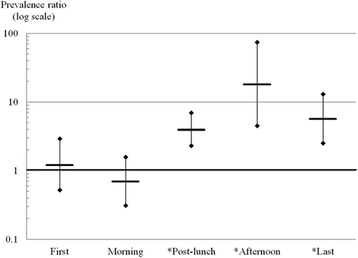Sleepiness while driving and shiftwork patterns among Korean bus drivers
- PMID: 29043087
- PMCID: PMC5632830
- DOI: 10.1186/s40557-017-0203-y
Sleepiness while driving and shiftwork patterns among Korean bus drivers
Abstract
Background: Sleepiness while driving has been regarded as a major cause of death due to traffic accidents. We compared the degree of sleepiness across five different working time periods (first, morning, post-lunch, afternoon, and last) among Korean bus drivers with different shift types (Daily two shift/Alternating day shift).
Method: We interviewed 332 bus drivers with two shift types (Daily two shift, 128; Alternating day shift, 204). The questionnaire included demographic information (age, alcohol consumption and history of disease), a sleep disorder diagnosed by a doctor, job duration, the number of workdays in the past month, average working hours per workday and week, sleepiness while driving (Karolinska Sleepiness Scale), and sleeping time for both workdays and off-days. We conducted log-binomial regression analyses and produced prevalence ratios (PRs) of severe sleepiness (KSS ≥ 7) while driving with 95% confidence intervals (95% CI) to identify the difference in sleepiness for five working times between both groups.
Results: For the first and morning periods, there were no statistically significant differences in the KSS scores between the two groups. However, from lunch to last driving, drivers with Alternating day shift had a much larger proportion of severe sleepiness than those on Daily two shift. Thirteen (10.2%), 2 (1.6%) and 7 (5.5%) Daily two shift workers reported severe sleepiness in the post-lunch, afternoon and last periods. In contrast, 81 (39.7%), 63 (30.9%) and 64 (31.4%) of Alternating day shift drivers experienced severe sleepiness during the post-lunch, afternoon and last driving periods (p < 0.0001). According to the log-binomial regression analyses, Alternating day shift was associated with severe sleepiness from lunch to last driving. After adjusting for job duration, alcohol consumption and sleeping time on workdays, the PRs were 3.97 (95% CI: 2.29-6.90) post-lunch, 18.26 (95% CI: 4.51-73.89) in the afternoon and 5.71 (95% CI: 2.51-12.99) for the last driving period.
Conclusion: We found that Alternating day shift bus drivers suffered from more sleepiness while driving from lunch to last driving than Daily two shift bus drivers. This difference may be because Alternating day shift drivers had more irregular work schedules and longer working hours per day and week.
Keywords: Bus drivers; Karolinska sleepiness scale; Occupational drivers; Shiftwork; Sleepiness; Traffic accidents.
Conflict of interest statement
Ethics approval and consent to participate
The study was approved by the Institutional Review Board of Catholic University of Korea at Seoul St. Mary’s Hospital (approval ID: KC15OISI0398). Written informed consent was obtained from all participants before enrollment.
Consent for publication
Not applicable.
Competing interests
The authors declare that they have no competing interests.
Publisher’s Note
Springer Nature remains neutral with regard to jurisdictional claims in published maps and institutional affiliations.
Figures

Similar articles
-
An on-road study of sleepiness in split shifts among city bus drivers.Accid Anal Prev. 2018 May;114:71-76. doi: 10.1016/j.aap.2017.05.005. Accid Anal Prev. 2018. PMID: 28506403
-
Sleepiness, sleep, and use of sleepiness countermeasures in shift-working long-haul truck drivers.Accid Anal Prev. 2015 Jul;80:201-10. doi: 10.1016/j.aap.2015.03.031. Epub 2015 May 20. Accid Anal Prev. 2015. PMID: 25957933
-
[Tiredness and sleepiness in bus drivers and road accidents in Peru: a quantitative study].Rev Panam Salud Publica. 2004 Jul;16(1):11-8. doi: 10.1590/s1020-49892004000700002. Rev Panam Salud Publica. 2004. PMID: 15333261 Portuguese.
-
Time of day, time of sleep, and time on task effects on sleepiness and cognitive performance of bus drivers.Sleep Breath. 2022 Dec;26(4):1759-1769. doi: 10.1007/s11325-021-02526-6. Epub 2022 Jan 11. Sleep Breath. 2022. PMID: 35013897 Free PMC article.
-
Vehicle accidents related to sleep: a review.Occup Environ Med. 1999 May;56(5):289-94. doi: 10.1136/oem.56.5.289. Occup Environ Med. 1999. PMID: 10472301 Free PMC article. Review.
Cited by
-
Research gaps and needs for preventing worker fatigue in the transportation and utilities industries.Am J Ind Med. 2022 Nov;65(11):857-866. doi: 10.1002/ajim.23346. Epub 2022 Mar 17. Am J Ind Med. 2022. PMID: 35301725 Free PMC article. Review.
-
Work Ability and Vitality in Coach Drivers: An RCT to Study the Effectiveness of a Self-Management Intervention during the Peak Season.Int J Environ Res Public Health. 2019 Jun 22;16(12):2214. doi: 10.3390/ijerph16122214. Int J Environ Res Public Health. 2019. PMID: 31234547 Free PMC article. Clinical Trial.
-
Shiftwork-Mediated Disruptions of Circadian Rhythms and Sleep Homeostasis Cause Serious Health Problems.Int J Genomics. 2018 Jan 21;2018:8576890. doi: 10.1155/2018/8576890. eCollection 2018. Int J Genomics. 2018. PMID: 29607311 Free PMC article. Review.
-
Effects of Sleep Deprivation and Hazard Types on the Visual Search Patterns and Hazard Response Times of Taxi Drivers.Behav Sci (Basel). 2023 Dec 8;13(12):1005. doi: 10.3390/bs13121005. Behav Sci (Basel). 2023. PMID: 38131861 Free PMC article.
References
-
- Korea Transportation Safety Authority. 2015. http://www.ts2020.kr/ind/prt/InqDetNANNewsData.do?ctgCd=&searchCtgCd=&bb...=.
LinkOut - more resources
Full Text Sources
Other Literature Sources
Miscellaneous

